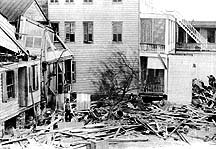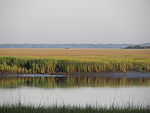1893 Sea Islands hurricane
 Damaged houses in Beaufort, South Carolina | |
| Meteorological history | |
|---|---|
| Formed | August 15, 1893 |
| Dissipated | September 2, 1893 |
| Category 3 major hurricane | |
| 1-minute sustained (SSHWS/NWS) | |
| Highest winds | 120 mph (195 km/h) |
| Lowest pressure | 954 mbar (hPa); 28.17 inHg |
| Overall effects | |
| Fatalities | 1,000–2,000 |
| Damage | $1 million (1893 USD) |
| Areas affected | Georgia, South Carolina |
| IBTrACS | |
Part of the 1893 Atlantic hurricane season | |
The 1893 Sea Islands hurricane was a deadly major hurricane that struck the Sea Islands which was near Savannah, Georgia on August 27, 1893.[1] It was the 7th deadliest hurricane in the United States history, and was one of the three deadly hurricanes during the 1893 Atlantic hurricane season; the storm killed an estimated 1,000–2,000 people, mostly from storm surge. This is also the storm that made United States Life-Saving Service Keeper Dunbar Davis famous, by rescuing four ships. The long-term effects included strengthening Jim Crow at the expense of local Blacks.[2]
Meteorological history

Tropical storm (39–73 mph, 63–118 km/h)
Category 1 (74–95 mph, 119–153 km/h)
Category 2 (96–110 mph, 154–177 km/h)
Category 3 (111–129 mph, 178–208 km/h)
Category 4 (130–156 mph, 209–251 km/h)
Category 5 (≥157 mph, ≥252 km/h)
Unknown
Modern analysis of historical records has allowed the history of this storm to be pieced together, although the analysis is only an estimate since few accurate meteorological records were taken.
On August 15, 1893, a
Some of the inhabitants anticipated the storm and left the islands as quickly as possible. The conditions soon rapidly deteriorated on the island and the hurricane passed over sometime on the 26th. By now the hurricane was turning more and more towards the north. It moved parallel to the coast for about one hundred miles before making landfall.
Landfall occurred near
Impact
| Deadliest United States hurricanes | |||
|---|---|---|---|
| Rank | Hurricane | Season | Fatalities |
| 1 | 4 "Galveston" | 1900 | 8,000–12,000 |
| 2 | 4 "San Ciriaco" | 1899 | 3,400 |
| 3 | 4 Maria | 2017 | 2,981 |
| 4 | 5 "Okeechobee" | 1928 | 2,823 |
| 5 | 4 "Cheniere Caminada" | 1893 | 2,000 |
| 6 | 3 Katrina | 2005 | 1,392 |
| 7 | 3 "Sea Islands" | 1893 | 1,000–2,000 |
| 8 | 3 "Indianola" | 1875 | 771 |
| 9 | 4 "Florida Keys" | 1919 | 745 |
| 10 | 2 "Georgia" | 1881 | 700 |
| Reference: NOAA, GWU[3][4][nb 1] | |||

The hurricane carried with it a heavy
Although the hurricane was devastating, the
Damage was reported as far north as Maine. Some areas, particularly
See also
- 1893 Cheniere Caminada Hurricane
- 1893 Charleston Hurricane
- Hurricane Matthew
- Lists of Atlantic hurricanes
Notes
- ^ The storm category color indicates the intensity of the hurricane when landfalling in the U.S.
References
- ^ Gibson, Christine (September 2006). "Our 10 Greatest Natural Disasters". American Heritage Magazine. 57 (4). Archived from the original on October 15, 2006. Retrieved February 23, 2023.
- ^ Grego, (2022) .
- ^ Blake, Eric S; Landsea, Christopher W; Gibney, Ethan J; National Climatic Data Center; National Hurricane Center (August 10, 2011). The deadliest, costliest and most intense United States tropical cyclones from 1851 to 2010 (and other frequently requested hurricane facts) (PDF) (NOAA Technical Memorandum NWS NHC-6). National Oceanic and Atmospheric Administration. p. 47. Retrieved August 10, 2011.
- ^ "Ascertainment of the Estimated Excess Mortality from Hurricane María in Puerto Rico" (PDF). Milken Institute of Public Health. August 27, 2018. Archived (PDF) from the original on August 29, 2018. Retrieved August 28, 2018.
- ^ NOAA SLOSH model
- ProQuest 95079845.
- ^ David Longshore Encyclopedia of Hurricanes, Typhoons, and Cyclones pg. 286
- ^ Storm Swept Particulars of the Ruin brought by The Great Gale Many Points in New York, New Jersey and Pennsylvania SUFFER GREAT DAMAGE The Girard Guit September 1, 1893
- ^ Struck by a Cyclone Paterson Daily Press August 29, 1893
- ^ Huge Tidel Wave The Miamisburgh Bulletin September 1, 1893
- ^ New York's Storm It was a Veritable Tornado One of The Worst Ever Experienced The Lawrence Daily August 30, 1893
Further reading
- Grego, Caroline. (2022) Hurricane Jim Crow: How the Great Sea Island Storm of 1893 Shaped the Lowcountry South (u of North Carolina Press, 2022) online
- Grego, Caroline (2019). "Black Autonomy, Red Cross Recovery, and White Backlash after the Great Sea Island Storm of 1893". The Journal of Southern History. 85 (4): 803–840. S2CID 208811556.
- Jones, Katharine M. (1960). "The Big Storm of 1893". Port Royal Under Six Flags, The Story of the Sea Islands. Indianapolis & New York: The Bobbs-Merrill Company.
- Marscher, William; Marscher, Fran (2004). The Great Sea Island Storm of 1893. Macon, GA: Mercer University Press. ISBN 0-86554-867-6.
- Rosenfeld, Jeff (1993). "The Forgotten Hurricane". Weatherwise. 46 (4): 13–18. .
- ISBN 0-8369-9062-5) – a historical-fictionaccount from the perspective of the people affected.

